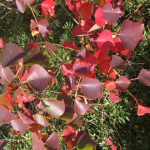In northwest Florida as we transition into fall, we don’t usually see a spectacular display of color change in the forest or our landscapes. Mixed in with the evergreen pines, oaks, and magnolias, we get sporadic spots of yellow and red from our native hickories, sweetgum, and sumac but otherwise it can be rather dull. It’s no wonder that people are reluctant to part with a blaze of red in their landscapes in the form of the invasive Chinese Tallow (Sapium sebiferum L. aka Triadica sebifera L.).
This fast growing, deciduous tree was initially introduced to the United States in 1776 by Benjamin Franklin. It was promoted by the U.S. Department of Agriculture in the early 1900s for the potential to create a soap industry. It was planted as an ornamental because it grows quickly in nearly any type of site condition, has attractive white fruit, and red fall color. Unfortunately, over the years it spread into numerous states and habitats unchecked displacing native vegetation and disrupting wildlife food sources. Eventually, it was recognized as an invasive pest and is currently listed as a noxious weed in Florida, Louisiana, Mississippi, and Texas.
Chinese Tallow is a prolific seed producer and is sexually mature as young as three years and may continue to produce viable seeds to the ripe age of 100. Although some birds eat the berries (part of the dispersal method), sap in the leaves and berries are poisonous to some other animals including cattle.
To prevent the continued spread of this plant, consider removing from your property and replacing with native species. Buy plants from reputable licensed nurseries with good weed management programs. Be able to recognize Chinese Tallow and do not accept plants from well-meaning gardeners who wish to share a foolproof shade tree!
For more information see Natural Area Weeds: Chinese Tallow (Sapium sebiferum L.)
USDA NRCS Plant Guide Chinese Tallow Tree Triadica sebiera (L.) Small
Alternatives to Invasive Plants Commonly Found in North Florida Landscapes
- Break the Breeding Cycle to Minimize Mosquitoes - June 26, 2025
- What’s the buzz about bee flies? - May 15, 2025
- What Vegetables Can I Plant in April? - April 3, 2025

